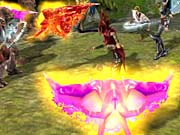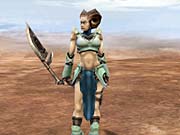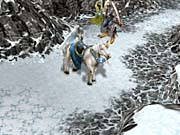Etherlords II Preview
Find out what you can expect from this collectible card game-inspired sequel from Nival Interactive.
Ask any serious players of collectible card games, and they'll tell you that the hobby is an insidious one. Card games, such as Magic: The Gathering and its various copycats, are a lot of fun to play, and the cards themselves feature varied fantasy artwork. However, the hobby can drive you into the poorhouse. The money you spend keeping up with your fellow players, through the never-ending purchase of booster packs and theme decks, almost seems as though it would be enough to keep you fully supplied with champagne and caviar instead.
As such, budget-minded gamers everywhere should celebrate the fact that Nival Interactive is putting the finishing touches on Etherlords II, the sequel to its underrated 2001 strategy game. The game's open beta test shows that the turn-based strategy series is moving forward with more of the same quirky game mechanics that combine tactical combat elements from Magic: The Gathering with epic role-playing strategies borrowed from Disciples and Heroes of Might and Magic. Like its predecessor, it seeks to provide the next-best thing to real collectible card gaming because you get everything you need in one box--for one affordable price.
But Nival isn't just rehashing the original game. The Russian developer is also planning some major changes to various aspects of the game design. While the collectible card-gaming features will remain mostly intact, the role-playing- and adventure-influenced storyline is being made more accessible. It's a change that both players and critics have asked for, and, according to the project manager, the company is glad to cooperate.
"Etherlords II is both an expansion of the combat and multiplayer aspects of the original game and a complete overhaul of the strategy portion to an RPG-like adventure," says Andrey Yemelyanenko. "Before we even finished Etherlords, we already knew where we wanted to take the sequel. And not only did we get the chance to make a sequel, but we found out that most of the fans and critics wanted the same things for Etherlords II that we did--a very rare coincidence in computer gaming. We knew that the game's strength was combat tactics, so we're making a lot of changes that add up to more tactical freedom and give you more options than the first game."
Despite this seeming overhaul of features, the basic premise of the sequel remains more or less the same as that of the first game. Etherlords II is set in the same fantasy land as its predecessor: the etherworld. The chaot, kinet, synthet, and vital races are still dueling with one another for control of the ether, also known as magic. Each continues to specialize in certain types of ether, symbolized by colors. The black synthnets, for instance, still rely on half-flesh, half-mechanical magical creatures, while the green vitals still depend on enchanted insects.

Where the original game focused on the time of changes that were caused by war and the displacement of the white lord--who is ruler of the Etherworld--the successor deals with the white lord's disappearance. According to Yemelyanenko, the races will once more be "at each other's throats" amid this chaos. There will also be a mysterious new race creatures known as "the pale" to contend with. Your quest to resolve this conflict will take place over the course of five campaigns. You'll guide the lord of each race in these episodes, along with Diamanda, a central character who possesses the power to use ether from all four nations.
Even though the sequel's story and background seem similar to those of the original game, just about everything else will be new territory for Etherlords veterans. While Etherlords featured a combination of turn-based strategy and tactical card-combat, somewhat inspired by Magic: The Gathering, Etherlords II will be more story-based. Judging by what we've seen in the beta, similarities to Disciples and Heroes of Might and Magic look to be more pronounced this time around. Each race now features a single main hero, instead of the four that led each faction last time, so you can better identify with the combatants. A more intimate atmosphere has been emphasized by moving the camera closer to the protagonists. You can't see as much of the map in the new game, but the character detail is much greater, and the general appearance of the game seems much more similar to something like Disciples than the distant tactical view favored in the first Etherlords.
Sorcery by Turns
Etherlords II will also introduce other fantasy role-playing elements. Characters will have an inventory system, interact with nonplayer characters, and write down key information in a journal. Side quests will be a major part of each campaign, so you'll be able to experiment with different approaches to the main storyline and can take different routes to reach different conclusions.

"These were the most asked-for changes, and it is exactly the direction we wanted to go with the sequel," explains Yemelyanenko. "What you get is a much more involving game that draws you in. You're not a faceless controller anymore. You are in the game."
Card-based tactical combat has been recognized as the first game's major strength, so this is being refined rather than reworked. The developer is focusing on giving players more options, largely through a new inventory system that allows spells to be dropped from active to reserve decks whenever the player isn't actively engaged in combat. So now you can adjust your tactics before waging war, just as collectible card game players can adjust their decks before taking on specific opponents. Another major tweak involves the automation of the rune system. Players now acquire the runes that power magic instantly--based on level and experience. This offers a marked improvement over the tiresome system of the previous game that required you to purchase runes from shops scattered all over the map.
Accessibility is a primary reason for these changes. Many players complained that Etherlords was too difficult, so Nival looked for ways to make the combat easier to understand. In addition to the above, Etherlords II will feature rebalanced combat, with the easiest difficulty setting programmed as the default, an extensive tutorial, and even a feature that allows multiplayer duels to be recorded and shared online so that beginners can watch and learn.
Virtually all of the creatures and spells from the original game are being brought back for Etherlords II. Experienced players should be able to sit down and get right into a game without worrying about a steep learning curve. However, the pale, the game's mysterious new faction, will prove to be an interesting addition to the game. The pale not only plays a key role in the story, it also includes 15 new creatures and 45 spells that can be used by each of the four races.
"Pale creatures use different magic than 'light' creatures," explains Yemelyanenko. "Some of these spells are effective only against other pale creatures, some are effective against anyone, and some indirectly affect your tactics by increasing the cost of different creatures or spells." In general, pale creatures are relatively inexpensive and are, at the same time, very powerful; but they are also stubborn and can have a higher cost of use in the long run. For example, some of them may require you to sacrifice one of your light creatures in order to use them in combat. Paleness also affects places and structures. Within a certain radius of these places, your heroes begin to lose health and experience, and their spells will not work in the same ways as they do under normal conditions. All of these additions are meant to give you a multitude of tactical options in combat."

The developer has also carefully scrutinized the multiplayer game. Nival is adding two new modes of play: blind and round table. These modes should be familiar to Magic: The Gathering players, as they are slightly altered versions of sealed-deck and draft tournament games, respectively. Blind will provide dueling players with random sets of spells, creatures, and artifacts, while round table will pit up to eight players in elimination rounds.
About the only aspect of Etherlords that isn't being renovated for the sequel is the graphics engine. The new game is still based on the foundation provided by the 2000 role-playing game Evil Islands, though the camera is being adjusted, and the creatures and environments are getting higher-resolution textures. New magic and environmental effects are also being added. Nival is also adding new music, atmospheric effects, and voice samples. Etherlords II is scheduled for release later this month.
Got a news tip or want to contact us directly? Email news@gamespot.com
Join the conversation